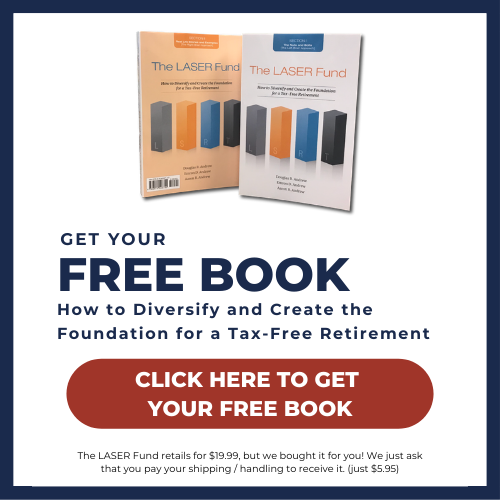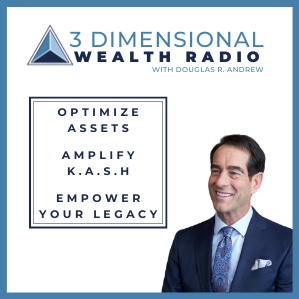I often get the question: “How can I get money out of my IRAs and 401(k)s with the least amount of tax?” It’s not just regular folks who wonder–a lot of financial advisors, CPAs, and tax attorneys attend my advanced continuing education courses to answer that very same question.
As a financial strategist, I’ve been helping people optimize their financial assets and minimize taxes for over 45 years. In that time, I’ve helped many, many people convert their IRAs and 401(k)s to better strategies, as you’re going to learn here.
WHO DO YOU WANT TO BE?
To help bring these principles to life, I’m going to use an analogy featuring two characters: Mr. Taxed-to-the-Max and Mrs. I’ve-a-lot-More.
Mr. Taxed-to-the-Max is a regular, high-achieving guy. He follows the herd and keeps his money in traditional IRAs and 401(k)s. After age 59 and a half, he could begin taking withdrawals without a 10% penalty, but he doesn’t need the money yet. So he continues to defer, postponing paying taxes on those IRAs and 401(k)s. Like so many people, he thinks, “Well, why should I tap into it, if I haven’t retired yet?”
By age 60, Mr. Taxed-to-the-Max has $500,000 in his IRAs and 401(k)s. Over the next 10 years, he earns 7.2%, doubling his total account value to $1 million. He begins taking out money at age 70 for annual retirement income—let’s say 7.2% of his account value, so that’s $72,000 a year. Because he and his spouse have to pay tax on withdrawals the rest of their lives, their after-tax income is much lower, around $43,000 to $44,000 a year. That’s not a lot to live on, especially as inflation continues to take a bigger and bigger bite out of their money.
Now what about the other character in our analogy, Mrs. I’ve-a-lot-More? By age 60, she realizes what’s coming with taxes if she leaves her money there. Instead she decides to do a Strategic Rollout.
Over the next five years, she pays just $150,000 in taxes. Compare that to Mr. Taxed-to-the-Max. By the end of their life expectancy, he and his wife end up paying nearly $900,000 in taxes.
Mrs. I’ve-a-lot-More, who only pays $150,000 in tax over five years, takes the net after-tax money and repositions it into a maximum-premium Indexed Universal Life policy, my favorite vehicle. This vehicle allows her to accumulate her money tax-free, access her money tax-free, and transfer hermoney income-tax-free when you die.
So essentially in this example, Mrs. I’ve-a-lot-More ends up with double the net spendable income in retirement—nearly $90,000—compared to Mr. Taxed-to-the-Max with his $43,000 to $44,000. And when she dies, she leaves behind significantly more, income-tax-free.
THE CHALLENGES OF 401(K)s & IRAs
This comparison illustrates why industry experts have been questioning the wisdom of IRAs and 401(k)s for years. In 2009, a Time magazine article explored why it’s time to retire the 401(k) and do something better instead.
In 2017, a Wall Street Journal article reported the original champions of the 401(k) lament the day they ever came up with the idea. They never meant the account to be a primary retirement savings vehicle. It’s subject to tax on the backend, and since taxes are likely not going down that makes those in retirement vulnerable to the impact of taxes. Adding to that, inflation often erodes away the purchasing power of those dollars.
And then there’s the fact that with IRAs and 401(k)s, your money is at risk in the market. From 2000 to 2010, millions of Americans lost 40% of the value of their IRAs or 401ks twice due to market volatility.
From 2000 to 2010, none of our clients lost a dime of their money in properly structured Indexed Universal Life insurance policies due to market volatility—and many doubled and tripled their money. That’s because their money was LINKED to the market, not actually IN the market.
Another drawback to IRAs and 401(k)s? Required Minimum Distributions. Currently, Uncle Sam requires you to take RMDs at age 72. If you don’t take those RMDs, you get hit with a penalty of 50% on top of the tax!
This means that, let’s say at age 72, you’ve got $1 million dollars in IRAs or 401(k)s, and you’ve been deferring thinking you’re saving tax. Let’s say your life expectancy from that point is another 20 years. At age 72, if you do not withdraw 1/20th that year, which would be $50,000, you would incur a penalty of $25,000, on top of the tax you’d pay on the full $50,000.
The government is dead serious about getting you to take your money out. Why? They are counting on that tax revenue. That’s why they created RMDs—you’re REQUIRED to take money out so Uncle Sam can feast on the taxes you’ll pay on your withdrawals.
Americans have been sold these “tax-deferred” plans, thinking they’re saving money by contributing pre-tax dollars and putting off paying taxes until they withdraw the money later in retirement. But…you’re not saving tax. You are actually compounding, increasing the tax and delaying the inevitable.
Despite what folks might assume, your current tax bracket is likely the lowest bracket you will ever be in from this point forward. As you get into your retirement years, you tend to lose deductions from things like real estate interest, dependents, and business expenses that you enjoyed in your younger years. And the American dollar will never be worth more than it is today because of inflation.
To save yourself from outliving your money, you can do what I call a Strategic Rollout to strategically get your money out of your IRAs or 401(k)s, dramatically reduce the amount of tax you will pay, and possibly double or even quadruple your net spendable income. We have helped hundreds, if not thousands of folks do this–and it’s an approach that may be worth exploring for yourself.
WANT TO LEARN MORE?
Watch the Video – Watch the related YouTube video to see me explain “How Can I Get Money out of My IRAs and 401(k)s with the Least Tax?” (and while you’re there, be sure to subscribe to my YouTube channel so you don’t miss a thing!).
Elevate Your Financial Dimension – Find out how you can improve your Financial Dimension journey and seize the liquidity, safety, predictable rates of return, and tax advantages of a LASER Fund. Explore the in-depth financial strategies and learn from real-life client experiences by claiming your free copy of “The LASER Fund” book at LASERFund.com. Just pay for shipping and handling, and we will send it to you, absolutely free.
Join a Webinar – Want to find out if a LASER Fund (a maximum-funded, properly structured indexed universal life insurance policy) is right for you? Join us for an upcoming webinar where you can explore these strategies.


